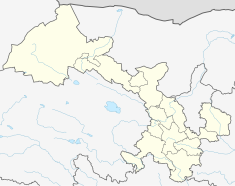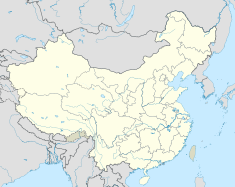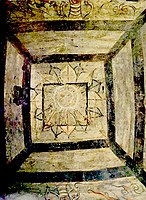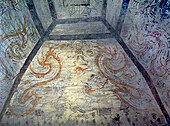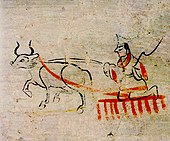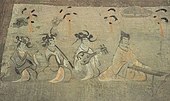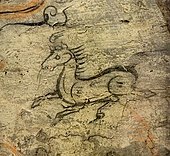Dingjiazha Tomb No. 5
| Dingjiazha Tomb No. 5 | |
|---|---|
| Native name Chinese: 丁家闸五号壁画墓 | |
 Portrait of the occupant | |
| Type | Underground tomb |
| Location | Jiuquan, Gansu, China |
| Coordinates | 39°51′16.8″N 98°26′6.6″E / 39.854667°N 98.435167°E |
| Built | late 4th-mid 5th century A.D. |
The Dingjiazha Tomb No. 5 (
The tomb is divided into two rooms, with murals covering the walls and ceilings of the entry room, creating a multi-level display of the lord's place in the world, between sky above and his workers below.
The image of the musicians and dancers is known as the Music and Bai Opera (乐伎和百戏图 Lè jì hé bǎi xì tú), part of the overall picture of the lord and his domain, known as Leisurely life, travel, and music (燕居行乐图).[2][4] It features musicians playing waist drum (细腰鼓), flute (长笛), lute (阮咸琵琶), and guqin (古琴). The lute shown here was relatively new to China, or in the process of entering China, and is one of the earliest lute images in China.
Gallery
-
Lotus above the world, looking down on heavens and earth below
-
Heavens North ceiling
-
Heavens, West ceiling, Queen Mother of the West, sits opposite to the King of the East, Dong Wanggong (东王公). She is a Taoist goddess, but worship of her predates Taoism.
-
Heavens, East ceiling, King of the East, (东王公 Dōng Wánggōng). He is a Taoist god, also known as the Eastern parent, he sits opposite of the Queen Mother of the West.
-
Heavens, South ceiling, a flying apsara or feitian (飞天).
-
Peasant and ox harrowing field
-
Lute or pipa player
-
Musicians
-
Fox painted into heavens in the tomb art
-
Horses
-
Horse painted into heavens in tomb art
-
Dancers and musicians
-
A horse painted into the heavens of the tomb.
-
Workers in the fields
-
Nude girl harvesting, monkey in tree
-
Dancer
-
Person flying in skies in tomb painting, an apsara?
-
Harvesters in orchard
References
- ^ a b Zhu, Fengsh (September 2014). "墓主燕居行乐图探考". 活力杂志 [Vitality Magazine]. 黑龙江 [Heilongjiang]: 黑龙江日报报业集团 [Heilongjiang Daily Newspaper Group]. Retrieved 24 September 2018.
[Information about the magazine article this ran in is at www.xueshu.com/hl/201410/3683520.html] 绘有此壁画的墓于1977年发现,根据墓室形制、随葬品及壁画上的乐器腰鼓,可考订其时在十六国时期的后凉至北凉之间。腰鼓是西域乐器,据《册府元龟》载,乃吕光灭龟兹〈公元384年〉时传人,则此墓的上限当在公元四世纪末,下限止于北魏破酒泉那一年〈公元441年〉 [translation: The tomb with this mural was discovered in 1977. According to the shape of the tomb, the funerary objects and the drums of the instruments on the murals, it can be dated between the post-six period and the north cool period. The waist drum is a Western musical instrument. According to the "Yuanfu Yuangui", it was the Lu Guangguang who vanquished Kucha (AD 384). The upper limit of this tomb was at the end of the fourth century AD, and the lower limit ended in the year of the Northern Wei Dynasty. 441 years]
- ^ a b c d 朱 [Zhu], 一点头 [Nod] (September 23, 2017). "酒泉丁家闸十六国墓 [Jiuquan Tomb of Jiujiao Dingjia Gate]". sohu.com. Retrieved 24 September 2018.
The top of the top [peak of the pyramidal ceiling] is painted in the middle with a lotus [overlooking everything below]. The following [everything below the lotus] is divided into five layers by ribbon. [Illustrated in] Painting, the content includes the three levels of heaven (two layers), human world (two layers), underground (one layer).
- ^ "Painting Zhongqin • Jiuquan mural (North Cool)". blog.sina.com. 25 June 2014. Retrieved 24 September 2018.
- ^ Liu, Rendao (ed.). "020 "Lee and Bai Opera"". readers365.com. – has a complete list of editors and researchers
Notes
The names change when using electronic translators. The following explain areas not explained well by translators:
- Zhu, Fengsh paper referred to a Post-Six period (后凉), which was the Later Liang (Sixteen Kingdoms), from 386 AD ~ AD 403
- Zhu, Fengsh paper referred to a North Cool period (北凉) which was the Northern Liang, from (397-439)
- Zhu, Fengsh paper referred to the waist drum as a "Western musical instrument" and talked of the conquest of Kucha as being useful in dating the tomb. Kucha was a non-Chinese land to the West of the Chinese, whose music would come to influence China. It was conquered by Lü Guang in 384 A.D.

